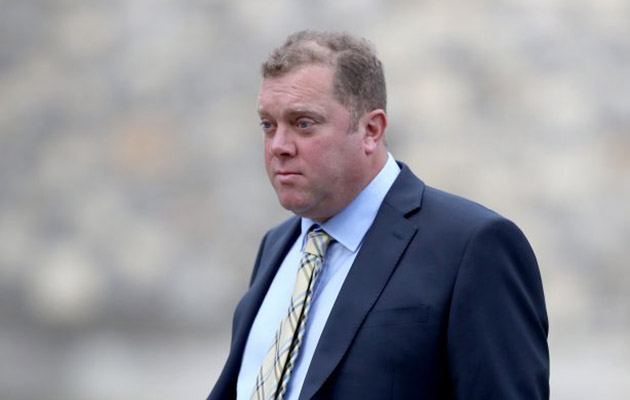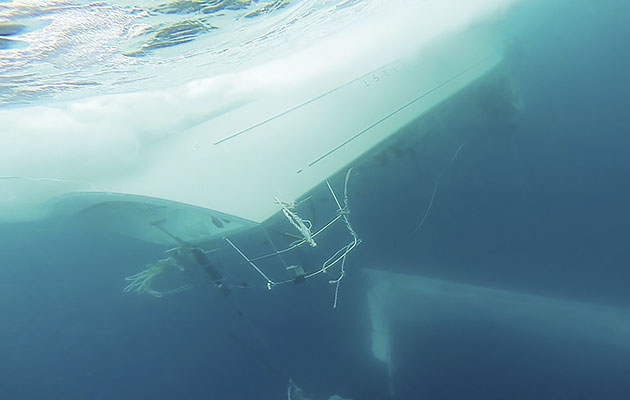No verdict on manslaughter charges but company director found guilty of failing to operate the yacht safely.
After a complex six-week trial, Stormforce Coaching boss Douglas Innes was found guilty of failing to ensure the safety of the yacht Cheeki Rafiki, which capsized mid-Atlantic in 2014, with the deaths of four men. Innes was not convicted on four charges of manslaughter by gross negligence. The Crown Prosecution Service (CPS) is seeking a retrial on those counts.
Innes, 42, and the company Stormforce Coaching, which operated the Beneteau 40.7, were separately convicted of failing to ensure the vessel was operated in a safe manner between 18 March, 2013 and 18 May, 2014, contrary to section 100 of the Merchant Shipping Act 1995. The jury at Winchester Crown Court convicted on both charges by a majority of 10-1 on 14 July, having taken four days to consider the evidence.
However, the jury failed to reach a verdict on four charges of manslaughter by gross negligence. Nigel Lickley QC for the prosecution said they would be seeking a retrial on those charges. The judge Mr Justice Dingemans released Innes on unconditional bail until a future hearing, which will be on a date yet to be set (likely to be in 2018).

Douglas Innes. PA Photos
The Cheeki Rafiki capsized mid-Atlantic in May 2014 on a return delivery from Antigua Sailing Week to Southampton. After an extensive and highly publicised search and rescue operation the yacht was discovered upturned, with its keel missing and the liferaft still on board.
The bodies of skipper Andrew Bridge, 22, from Farnham, Surrey, James Male, also 22, from Romsey, Hampshire, Steve Warren 52, and Paul Goslin 56, both from Somerset, were never found.
Structural safety standards
During the trial the prosecution told the court that Douglas Innes had not maintained Cheeki Rafiki to the standard expected by a reasonably competent and prudent manager because he had not had the yacht surveyed before setting off on a transatlantic, and because the yacht was not coded at the time.
The defence said that the Cheeki Rafiki had been surveyed when Stormforce Coaching took over management of the yacht in 2011, that ongoing maintenance had revealed no indication it required another survey, and that coding related only to equipment required for commercial activity and would not have guaranteed the structural safety of the yacht.
Much of the discussion in court related specifically to grounding, and raised the question of whether every yacht should be routinely surveyed (and, if coded, reported to its coding authority) after every grounding.

Cheeki Rafiki – Stormforce Coaching
The MCA’s advice on this specifies that the coding authority should be notified ‘in cases where the vessel suffers major damage…’ or ‘minor damage, detrimental to the safety of the vessel’. In the case of Cheeki Rafiki, the court heard how the yacht had two minor groundings in 2013, one described as a low speed touch to the mud in Shamrock Quay, Southampton, and another the same year as a minor grounding when the yacht drifted in Lymington River after the engine failed.
Cheeki Rafiki had also grounded in 2011, hitting Ryde Sands on a training day. Among the witnesses who had been on board there was disagreement whether the yacht was doing 2.5-3 knots through a tack, or 5-6 knots. The court was told that the keel bolts had been inspected for cracking afterwards and the yacht was lifted out ten days later.
The yacht was not surveyed or reported after any of the three groundings.
Why do keel failures happen and what can we do to prevent it?
MCA Coding requirements
The prosecution also raised the question of whether Cheeki Rafiki should have met coding requirements and, if so, to what standard.
The yacht had previously been coded under Category 2, which requires the vessel to remain within 60 miles of a safe haven when operating commercially. That coding had lapsed before Antigua Sailing Week, and so the yacht had not had a three-year inspection, known as a mid-term inspection, before she left.
The prosecution argued that if Cheeki Rafiki had been coded as Category 0 (for unrestricted waters), she would have been surveyed before departure and would have carried a higher specification of safety equipment, including ‘float free’ liferafts, which deploy automatically.
The defence case stated that Innes had complied with the coding law by refunding guests who had paid for training days before Antigua Sailing Week, and that because the return transatlantic crossing was not a commercial voyage, the yacht did not require coding. They also said that because the Cat 2 inspection was purely an equipment inspection, carried out in water, it would not have identified any structural issues pertaining to the keel or keel attachment.
The prosecution put it to the court that the yacht was not structurally sound and safe before leaving Antigua, that the keel matrix had begun debonding from the hull, and that the keel bolts, particularly bolt nine [the furthest aft full-size bolt] had failed. The defence stated that these points are impossible to prove as the yacht could not be recovered.

Photo: US Navy
Multiple expert witnesses were called to court, including surveyors and metallurgists, who were often in disagreement about how the images of the upturned hull of the Cheeki Rafiki could be interpreted, and whether an inspector would have noticed any underlying problem with the keel bolts.
Following the verdict on 14 July, the RYA immediately suspended recognition of Stormforce Coaching as an RYA training centre. The RYA also suspended all instructor qualifications held by Douglas Innes, pending referral to the RYA tribunal.
In a statement on the company website, Doug Innes announced that following the company’s loss of accreditation Stormforce Coaching had ceased trading.
In the statement Innes wrote: ‘I would like to thank all those who have worked, trained and raced with Stormforce Coaching over the last 16 years. Over 20,000 sailors and powerboaters have joined us on training courses and our race crews have achieved podium results in numerous international regattas. This is in part a great testament to many of the staff that have worked with us. I would particularly like to thank those who have supported us and put their trust in us through the last three years. I am truly sorry this is how it has ended.’
Series of events leading up to the tragedy
During evidence, the court heard how the Cheeki Rafiki set out from Antigua on 4 May, 2014, taking a northerly course.
An email from Stormforce Coaching to the yacht sent on 6 May read: ‘Go north, do not pass go, go north, do not collect £200, go north.’
The yacht reached around 30°N on 10 May, when it began heading north-east. An email was read out in court that the crew had sent on 14 May to Stormforce Coaching which read: ‘Why is my rum floating? James just hit a wave hard and it fixed the stereo.’
The following day, 15 May, at 2022 UTC, the yacht sent an email to Innes with the subject heading ‘Urgent’ which read: ‘We have been taking on a lot of water yesterday and today. Today seems worse I think stbd water tank has split so that it is drained checked hull and seacocks for damade [sic] but cant see any. I will go for a swim when weather improves in about 24 hours we are currently monitoring the situation horta is 900 miles away our position is Position 38deg 38 N, 048 deg 59W, thoughts from your end I will check emails in 2 hours.’
That was the final email communication from the crew. Douglas Innes received a call later that evening from the boat saying the situation was deteriorating, and notified Falmouth Coastguard.
At 0412 the following morning, skipper Andrew Bridge’s PLB was activated some 700 miles off Nova Scotia, Canada, and at 0714 that morning James Male’s PLB was also activated. The Maersk Kure spotted the upturned hull on 17 May but was unable to search or recover the yacht.
On 23 May the USS Oscar Austin located the capsized vessel and confirmed that the liferaft was still on board. During the trial, Graham Male, father of James Male, recalled seeing a photograph of the upturned vessel with the liferaft intact.
He told the court: “It was surreal, just seeing that liferaft, I just couldn’t believe it. I remember saying, I have seen enough.”




